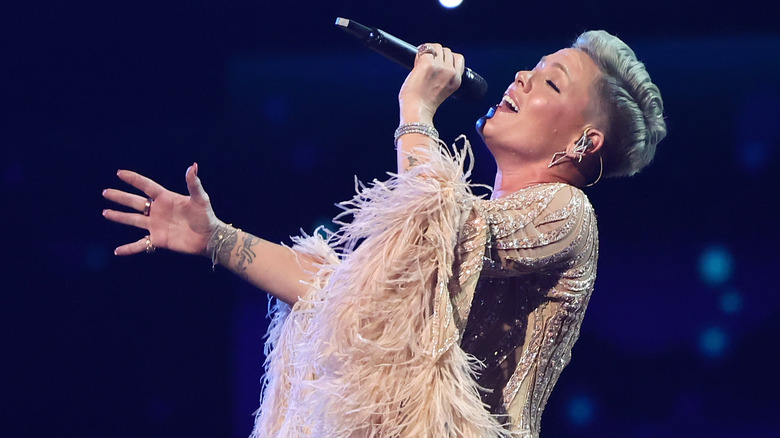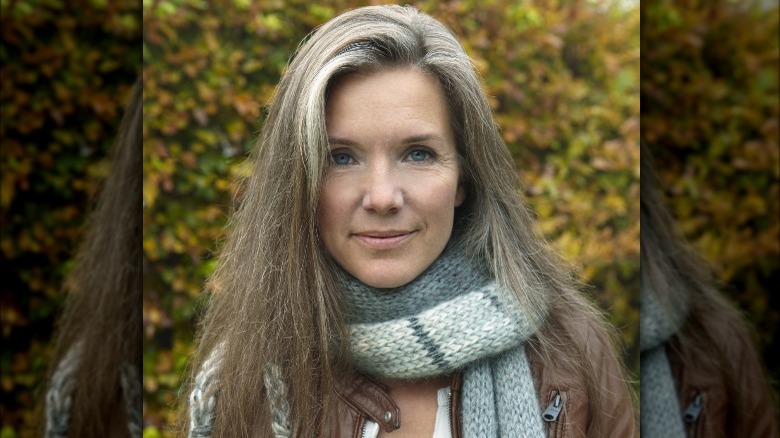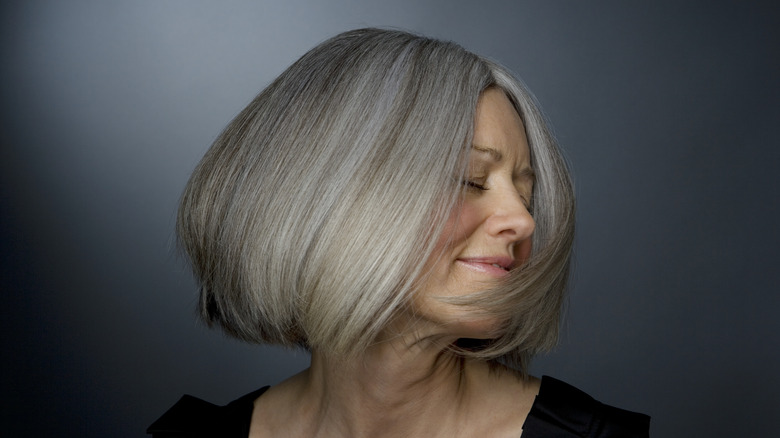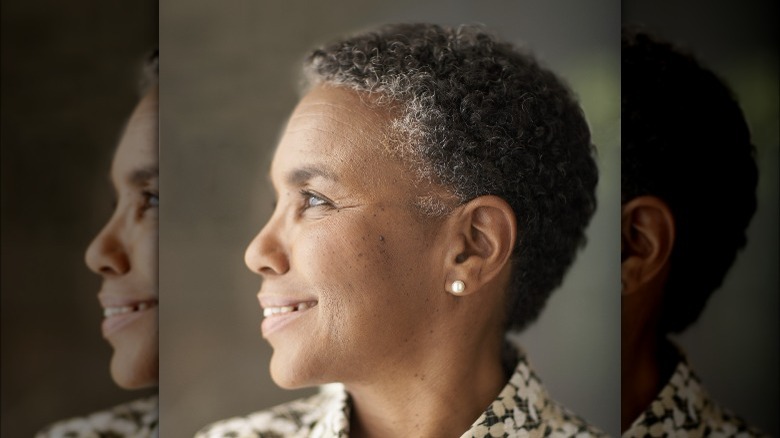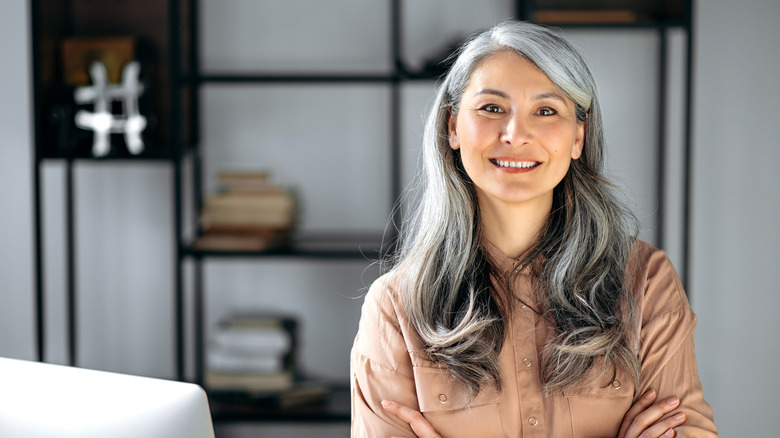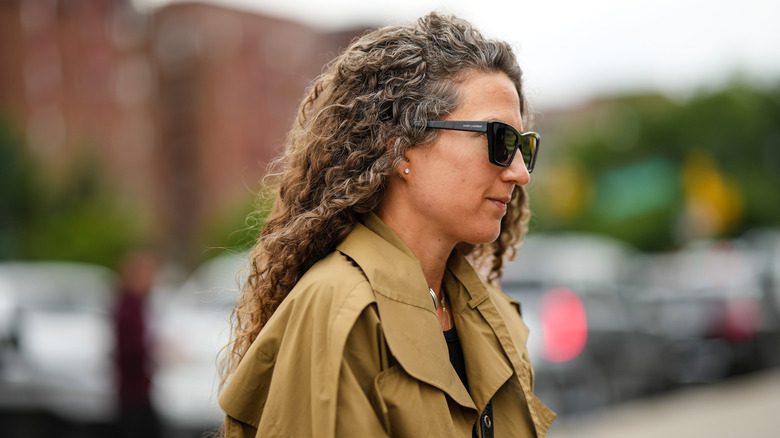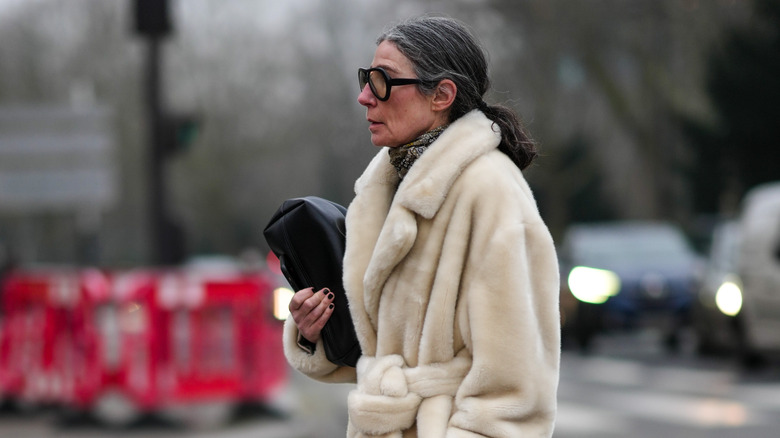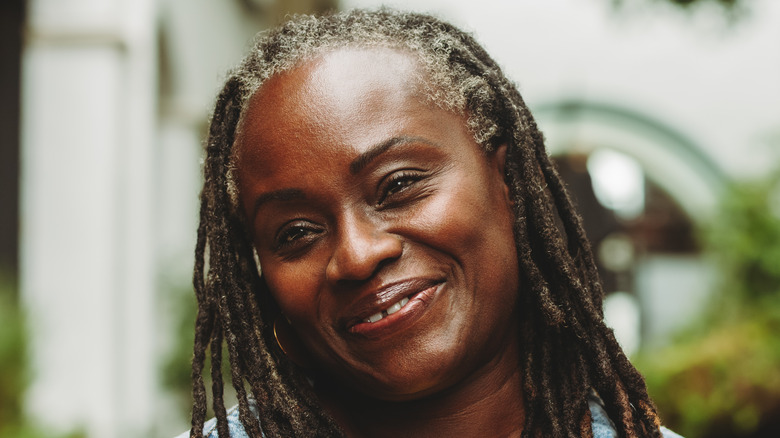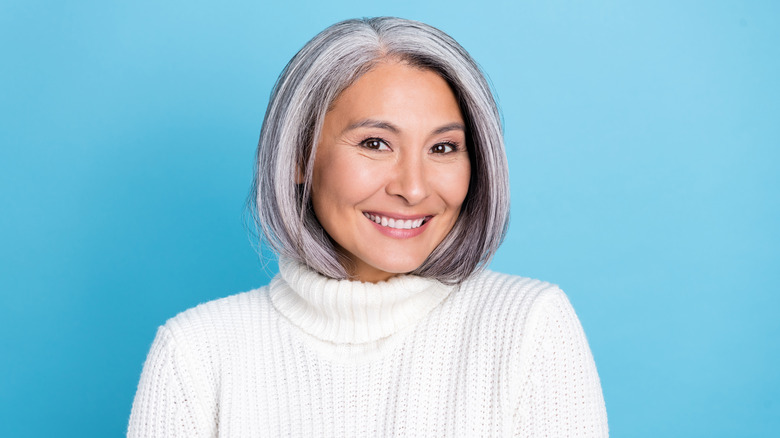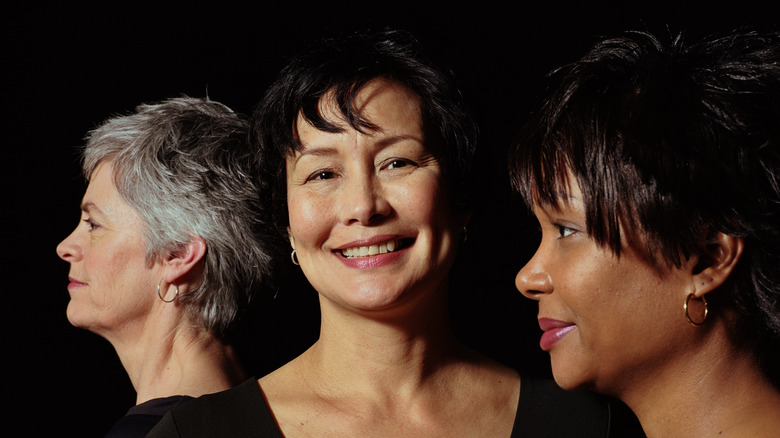Hidden Reasons To Consider Before Letting Your Hair Go Grey
Going grey can feel a bit intimidating in a world that continually sells women on the idea that they need to maintain their youth. For years, women have been told that their skin should bounce back as it did at 20, even if they're in their 50s. Their face should be wrinkle-free, their legs rid of cellulite, and their hair the luscious brown it was when they graduated college. It's not the same world where men can age gracefully, where the salt and pepper hair suddenly becomes attractive, and their wrinkles give them a look of wisdom. No wonder so many women have spent hundreds of thousands of dollars at the hair salon, the dermatologist, the gym, and the list goes on.
Going grey, however, is not an inherent sign of aging, and letting your hair turn its natural color is not something that solely happens when you're in your 80s and reminiscing about your youth. It can be gradual, come seemingly overnight, and arrive at any age, so why not embrace it? There are many hidden reasons why going grey is worth your time and attention. Not only is it a money saver, but it is inherently feminist in its practice. It'll help stop harmful chemicals from going into the environment, and it could give you a new vote of confidence. These are the hidden reasons why going grey is the best idea you can have.
Grey is actually really trendy at the moment
Sticking to trends is not a bad thing. We love a trend, and as it happens, grey hair is very in at the moment. As noted by Byrdie, grey and silver hair has been seen all over the red carpet and on celebs representing a wide age gap. Not only is the look mature when it needs to be, but the silver undertones have allowed for some fun shades to shine through on stars in their 30s, 40s, and beyond. To weigh in on the issue, Byrdie talked to hair and color professionals Nikki Lee and Denis De Souza to get the 411 on all things grey hair.
Reality star and bonafide socialite Kim Kardashian rocked long gray, silvery hair and looked stunning. The experts said that she likely used a hair oil to help maintain its shine, taking advantage of the silvery undertones to really dazzle on the carpet. Actress Lucy Boynton rocked a blue-grey look at the Met Gala and looked like Elsa from "Frozen" in the best way possible. Taking a cue from the short-hair queen herself, P!nk has often dazzled in a grey pixie cut, arguably starting the short, natural hair trend in the first place.
"P!nk looks beautiful with this cut and gray hair that shows off her beautiful face," De Souza told Byrdie. We couldn't agree more.
Accepting your grey hair can come as a gradual process or a fresh, bold change
There are a lot of myths surrounding grey hair, one of which is that it arrives overnight. There are ads upon ads that'll tell you that one day in your 50s, you'll wake up with a grey head of hair that was brown the night before — this is, of course, an exaggeration (though the narrative surely sold a bunch of hair dye products over the years). As it happens, going grey is a gradual process that takes months, if not years, to fully take over your locks. Andrew Fitzsimons, a celebrity stylist, told Martha Stewart that the process is all about the chemicals in your hair — natural or otherwise.
"When you grow out graying hair, the hydrogen peroxide that naturally exists in the hair follicles begins to build up and block the production of melanin, which is our hair's pigment," Fitzsimons explained. "So technically, our hair doesn't just turn gray — it really grows out gray."
With that in mind, accepting your gray hair can come in a number of ways. You can let it grow out, as Fitzsimons notes, or you can take going grey as an opportunity to cut off all your processed and colored hair and start from scratch with your natural look. No matter what you choose, you'll look stunning!
Embracing your grey can save you cash and time
Heading to the hair salon every month can feel like a self-care treat at times, but when you have a whole day of errands to get done, sitting under the dryer and waiting hours for your hair to color can get old quickly. Going grey can save you a ton of time and money you would've spent at the salon. But how much money are we talking about? Is it worth embracing the grey? Author Anne Kreamer who wrote the book "Going Gray" decided to take the plunge and find out how much she had spent throughout 25 years to keep her grey hair covered up. The verdict? About $65,000.
"If I had invested that money, my daughters' college education or my retirement would have been taken care of," Kreamer told Today. "It is an actual choice that makes a difference in people's pockets."
Of embracing grey hair, Kreamer told NBC that she "adores" it for more reasons than one. "It's thrilling. It's fantastic," she said. "My hair is shinier, healthier, more vibrant. People ... stop me, literally, on the street to tell me, 'I love the color of your hair.' That never once happened in 25 years of dyeing my hair." If an extra $65,000 sounds good to you — and how could it not — you might want to start thinking about embracing your natural look.
Not all grey hair is alike — undertones can make the pigment unique
Many of the grey-covering hair dye ads on social media and our TV screens would like you to believe that all grey hair is built the same: It's flat, dull, and in need of covering. But that couldn't be further from the truth, as many grey-hair owners have a variety of undertones that shine through, giving their locks a fresh and exciting look. As noted by Southern Living, there are so many undertones that shine through when grey hair is embraced — many have even gone to the salon to try to replicate such a look!
Starting with a classic, the "snow-capped" grey hair look is sassy, classy, and allows black undertones to shine — so many people have gone to the salon to get it.
Another amazing grey color combo that will draw attention and make your locks look enviable is a blonde-grey hybrid. If you were a blonde for years and are going grey, let your hair transition over time and treat yourself to a new cut. The blonde and grey colors will combine to create a gorgeous ombré that would otherwise cost hundreds in the colorist's chair. If you have tight curls and are going grey, please — embrace your new color! The silver tips will create dimension, and your hair will have this amazing look that will turn heads. Who said that grey hair had to be boring?
Grey is not all about age
In movies, TV shows, and social media ads, you name it; grey hair is often used as an indication of old age. But remember when we said that there are a lot of myths surrounding grey hair? One of them is that it is directly linked to being elderly, as people can go grey in their 20s, 30s, and so on. Speaking on the matter with the University of Utah is Dr. Kirtly Parker Jones, a described "expert on all things woman." Noting that going grey is not linked to being "emotionally unhealthy," Dr. Jones debunked the myth that grey hair is related to age and stress, explaining that people across ethnicities tend to transition to grey hair a lot sooner than society would have us believe.
"Caucasian people tend to start going gray in their early 30s. Asian people in their late 30s and African-Americans in their 40s. Now, what's too early?" Dr. Jones questioned. "So you're 20, you have a few gray hairs. I'm afraid that's still normal."
Jones further explained that ensuring your hair gets the right nutrients is essential — but going grey is by no means the death sentence that so many of us have been led to believe.
Going grey is a very earth-friendly option
Of all the issues plaguing our world at this very moment, climate change has to be the most existential threat. With so many large companies and countries making up the bulk of climate polluting practices, it can feel futile to make small changes in your life to aid in environmental protection — but we're here to tell you that every little bit counts and one habit that you can give up to help minimize your footprint and help in the fight against climate change is dying your hair. As it happens, hair dye is very toxic not only to your head of hair but to the environment.
As noted by Vogue, hair color "isn't clean," and although there are more earth-friendly options available, "A completely sustainable option isn't available on the market yet." The majority of hair color options include chemicals such as ammonia. When this is washed down the sink, those chemicals will make it to the ocean at some point, harming marine life. Other substances, including benzenes, toluene, and lead, are also present in most hair dye products, which can damage aquatic animals and reefs.
"At the end of the day, hair color is just a mix of chemicals in different concentrations. Once mixed and rinsed off, it is all going down the drain," celebrity hairstylist Rod Anker told Vogue. So ditch the dye and embrace the grey — the Earth will thank you.
Grey is a bit of a power move
Just a stone's throw back in 2009, author Charla Krupp released a book entitled "How Not to Look Old." Detailing the book for Today, Krupp commented that women who go grey in the workplace were not only showing their age but risking their professional lives. "Women cannot afford to go gray in this economy," Krupp said. "When you're competing for a job with someone who's 10 years younger or 20 years younger than you are, being gray is the equivalent of wearing a necklace that says '57.' Would you do that? You have to convey the message that you're still in the game. I tell women, 'Go gray at your own risk.'"
While Krupp's dated assessment reflected the mentality back in 2009 — and likely represents some perspectives to this day — society is experiencing a bit of a renaissance when it comes to embracing natural beauty. One such professional woman, Maria Colsey Heard, went viral on LinkedIn when she shared her new headshot rocking her grey hair — it sparked a conversation that was long overdue. "It was, 'Wow, I really am in my 50s," the practicing lawyer told The Wall Street Journal. "I'm launching the new me."
Of the threat that going grey in the professional world can pose for women, gender studies professor Joan C. Williams told The Wall Street Journal, "It's both risky, and it's awesome." Why not be a trendsetter and change the professional game?
Grey is universally fashionable
When the COVID-19 pandemic hit, many of us traded our workwear and office desks for sweatpants and the couch. Working from home allowed many of us to give our skin a break from daily makeup and our hair some time away from the curling iron, and it's safe to say that many of us are better off for it. But of course, the prolonged closure of hair salons also forced some of us to embrace our greying hair finally — now that working in the office is becoming a bit more frequent again, we're here to tell you that you should keep your natural locks for a particularly fashionable reason.
When you go onto any clothing website or Pinterest or are scrolling through social media for professional inspiration, what do you see? Often, it's professional women looking sleek in the workplace and donning an outfit worthy of Olivia Pope status. The color palette? Grey, black, and white, with a pop of color in the shoe or the bag. Why not embrace your natural grey hair and complement the classy, put-together tones of the outfits you aspire to wear? Grey is a neutral — just like black, white, or navy — meaning that it'll go with anything. This versatility isn't always available, so why not give your grey hair a chance and let it shine with a fabulous outfit?
Embracing grey is one of the most feminist things you can do
While time is on the side of change, it does feel as though the rights of women, members of the LGBTQIA+ community, marginalized communities, and people of color are on the rocks. With the overturning of Roe v. Wade in 2022, Supreme Court decisions that allowed for gay and interracial marriage are suddenly at risk. With so much at stake, it can feel as though something as vain as hair couldn't make that much of a statement or a difference. Still, as Mary Ann Mohanraj wrote for Salon, embracing natural grey hair was one of the most feminist things she could do in a world that tells women they cannot age — that they should look perfect while sitting down and shutting up.
"I'd started going grey young and had been coloring my hair regularly since I was 25. For 15 years, I went through the monthly ritual," Mohanraj wrote. "We all live in a system that expects women to present a certain way, a system that penalizes those women who don't comply. I'm not going to argue that going grey is going to save the world. But I do think, for me, it's a feminist choice."
Arguing that going grey takes some societal pressure off women's shoulders, Mohanraj said that the more people who embrace their natural hair, the quicker cultural expectations will shift.
Going grey will save your hair from damage
Going grey will save your locks from a ton of damage when it comes to your hair. As noted by Healthline, our hair often goes through a ton of damaging practices to create the "perfect" look. Heat tools, blowouts, hair treatments — you name it; your hair can only take so much damage. Coloring your grey hair is just one such practice that can damage the follicles over time, so why not give it a rest?
Healthline notes that if you color your grey hair — particularly with bleach to make it blonde — you can burn your hair and scalp. If you are regularly dying your locks, this damage will continue over time. To nip this practice in the bud, it's recommended to go to a hairstylist and have them weigh in on the condition of your strands. A conditioning treatment could be the first step in restoring your grey hair, but if push comes to shove, you might want to cut it all off and start over. Lathering chemicals in your hair, leaving hair dye on for long periods, and taking heating tools to your locks will surely damage your follicles. Going grey will not only give you some time back that you would've sat in the salon, but it'll maintain and preserve the quality of your hair for years to come.
You can change it if you want to
With all this said — the time and money saved, the professional shifts, the feminist statements — you can always change your grey hair if you don't like it. Say you give it an earnest shot, embracing your changing head of hair for as long as you can — but you simply can't get behind it. That's totally OK; this is a judgment-free zone, and luckily there are some options that'll help your hair get back to how you like it. Speaking to Hair, L'Oréal stylist Tricia Cosgrove said that the best way to cover grey hair is all in the details. Rather than opting for a full hair dye job, highlights can actually help cover your grey while keeping the hair looking natural.
"The best tip I have is to consult a pro! Professional hairdressers are well educated in the chemistry of hair color. This really isn't the type of thing most people can tackle themselves, and corrective color gets expensive!" Cosgrove explained.
So, when you head to the salon, opt for a semi-permanent look that'll help disguise your grey while maintaining a look that doesn't scream "box dye." This way, your locks will have the look you want while also kicking the harmful habit of permanent hair dye to the curb.

